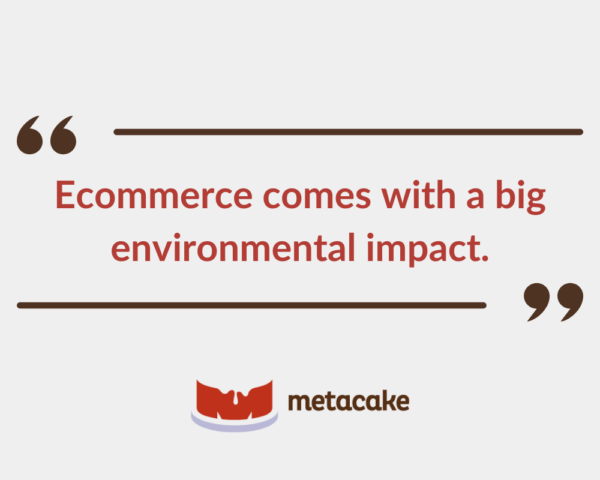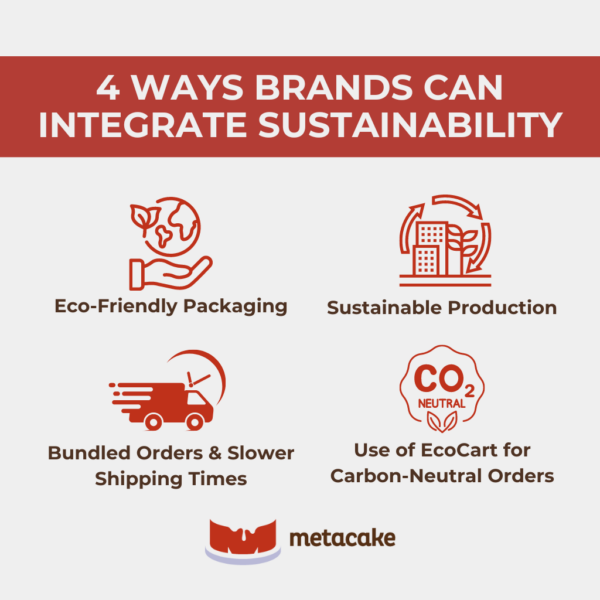
WHY SUSTAINABLE ECOMMERCE BUSINESSES ARE THE FUTURE
Ecommerce has grown rapidly over the last few years. Thanks to the internet, computers, and phones, shopping has been transformed. What once was a time-consuming effort is now just a click away.
COVID-19 only amplified this growth; with the whole world in lockdown, the demand for shopping without leaving the house skyrocketed. And that’s not just for trivial shopping — these days, you can buy groceries, electronics, and even your next house completely online!
It’s estimated that by 2028, half of all sales will be online through a variety of ecommerce stores.
All of this is fantastic for DTC businesses and consumers alike, but it does have an impact on the planet that we can’t ignore.
In this post, we’ll dive into the environmental impact of an increasingly ecommerce-driven world as well as four simple ways you can move your brand toward becoming a sustainable ecommerce business.
The Current Environmental Impact of Ecommerce
Unfortunately, ecommerce comes with a big environmental impact. In theory, shipping packages straight to doors seems more environmentally friendly than shipping them to stores that customers have to drive to — but in practice, this isn’t always true.
The greenhouse gases created from last-mile deliveries are a big contributor to this. Many customers have grown accustomed to speedy delivery and expect their packages to come within a couple of days after ordering. This comes at a price, and we’re not talking in dollars.
Freight movement is the fastest-growing source of greenhouse gas emissions overall, and last-mile freight is a major contributor to local air pollution, often in disadvantaged communities.
By 2030, last-mile delivery growth will increase carbon emissions globally by 30%. The myriad of cars, trucks, planes, and boats needed to ship packages around the world generates significant emissions, and expediting deliveries only adds to that.
Packaging orders to ship all over the world is also very resource-intensive. The packaging itself directly contributes to the environmental impact of ecommerce, creating a lot of waste in the form of boxes, mailers, fillers, and more.
The amount of cardboard packaging used in one year equates to 1 billion trees. That statistic alone fails to account for the other less eco-friendly types of packaging, like plastic.

How Do Consumers Respond to Ecommerce Sustainability Efforts?
Beyond the benefits of helping the planet, integrating sustainability into your ecommerce business can help you attract new customers (and retain your current ones!). The general consumer mindset is changing. Unlike their parents, younger generations are much more concerned about sustainability.
Consumers are increasingly concerned about the effects of climate change, and with social media providing rapid distribution of news and information, sustainability in ecommerce business is critical.
Let’s take a look at what Forbes found:
- 68% of millennials bought a product with a social or environmental benefit in the past 12 months.
- 87% of consumers will have a more positive image of a company that supports social or environmental issues.
- 88% will be more loyal to a company that supports social or environmental issues.
- 87% would buy a product with a social and environmental benefit if given the opportunity.
- 92% will be more likely to trust a company that supports social or environmental issues.
Considering the sheer number of stores available to consumers today, being the brand that cares about the planet can set you apart from other businesses and be the convincing factor for customers to buy from you.
Why Should Brands Care About Sustainability?
Millennials’ and Gen Zers’ opinions are important to business. Millennials alone command $360 billion in disposable income; their dollars are going to be impactful. The audience that businesses have to appeal to is changing, and quickly.
If you want to capture this large group of consumers, being outwardly eco-friendly plays an important role in attracting this audience.
A survey found that 70% of Millennials say that a company’s environmental focus influences their purchase decisions. In order to win this audience, a company has to consider the values of these consumers, which in recent years have trended toward an increased focus on sustainability.
A global study reveals that consumers are four to six times more likely to purchase, protect, and champion purpose-driven companies. Making sustainability a key facet of your ecommerce business offers a sense of purpose and will be important if you want to stay relevant with younger generations for years to come.

4 Ways Brands Can Integrate Sustainability
Making your brand more sustainable doesn’t require you to change your entire business model.
Changes like swapping out your old packaging for eco-friendly alternatives, finding new waste management solutions, or powering your offices with solar energy instead of fossil fuel energy can help make your business more eco-friendly.
As long as you communicate your efforts well, customers will take note, too!
Eco-Friendly Packaging
While eco-friendly packaging can be more expensive than traditional options, this is something that the majority of consumers would be willing to pay for. When surveyed, 60–70% of consumers said they would pay more for sustainable packaging.
Sustainable packaging comes in a variety of forms; packaging made from post-consumer waste, recyclable materials, or compostable materials are a few examples of things you can consider.
You can buy sustainable packaging from online stores like Ecoenclose and Arka, which offer eco-friendly options in a variety of shapes and sizes!
Sustainable Production
As you develop and create new products, you might want to consider using more sustainable materials and designs.
For example, instead of plastic cutlery, you might want to opt for a material like bamboo, which isn’t very resource-intensive or harmful to our planet.
Besides bamboo, concrete, reclaimed wood, and recycled steel are a few other materials you can consider using.
Every brand is different, so searching for the perfect eco-friendly swap for something in your products might take time, but it’ll produce a clear result that your customers will see every time they use your product.
Bundled Orders and Slower Shipping Times
Because the environmental impact of shipping is so great, offering your customers slower shipping options or bundling options can help alleviate this effect. By shipping orders slower, you can package more orders in every vehicle and be more efficient when sending orders out (as opposed to prioritizing speed).
Many brands offer free shipping for their slowest shipping times, which customers will opt for most of the time if they don’t need their order right away.
You can also offer bundling deals so customers will be inclined to buy what they need all at once, reducing the number of total packages shipped (which means more eco-friendly shipping!).
You might consider adding a note at checkout about how slower shipping times or bundled shipping options are more environmentally friendly. This’ll help manage customer expectations and provide additional incentive for going this route.
Use of EcoCart for Carbon-Neutral Orders
For the greenhouse gases you can’t get rid of in shipping, consider adding EcoCart to your sustainable ecommerce store! EcoCart is a free ecommerce plugin that allows businesses and their customers to offset the greenhouse gas emissions created from shipping and manufacturing their orders.
Carbon offsetting your order means that for all of the greenhouse gases emitted from your order, an equivalent amount will be captured from the atmosphere by way of projects, like forest protection or creating renewable energy, to reduce the carbon in the atmosphere.
For every order, either your brand or your customer can opt to pay a small percentage that goes toward a carbon-offsetting project of your business’s choice!
Some brands even use EcoCart to go carbon-positive, meaning that the amount of carbon they offset is greater than the amount of greenhouse gas emissions they create.
Christy Dawn and JuneShine are two brands that went carbon-positive with EcoCart and are able to help make a difference in our world and clearly demonstrate it to customers.
Where Can Your Brand Go Green?
Ecommerce is changing, and your brand should always be evolving too. While sustainability is a plus now, it’ll soon become a necessity in all businesses and industries. By integrating sustainability into your business model now, your brand will be ahead of the game and gain loyal customers easily.
Adding sustainability to your brand doesn’t have to be difficult. As we’ve discussed here, there are several ways you can make small changes to parts of your business model to integrate sustainability.
Even if you only start with one sustainability initiative, you’ll be making a difference. As long as you can communicate the work you’re doing to customers effectively, they’ll appreciate your love for the environment and reward you with their business.
If you’d like to learn more about migrating your business to a sustainable ecommerce business, reach out! We’d love to help.
Special thanks to our friends at EcoCart for this guest post!



